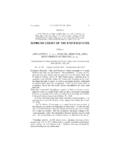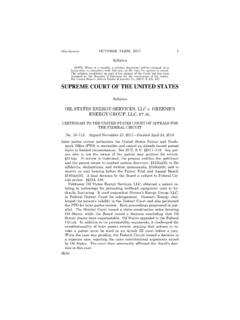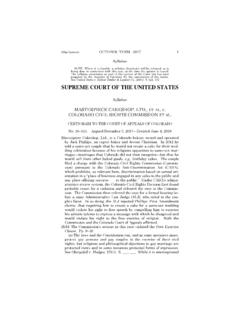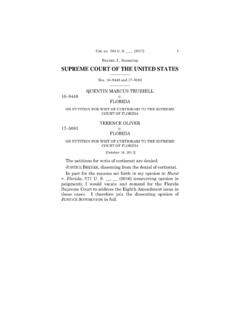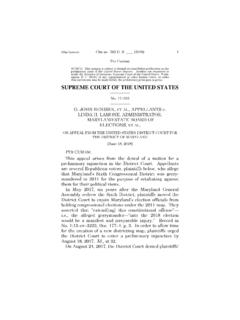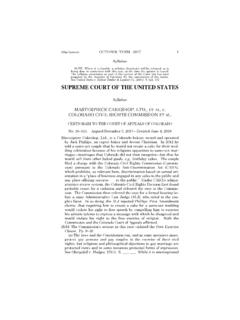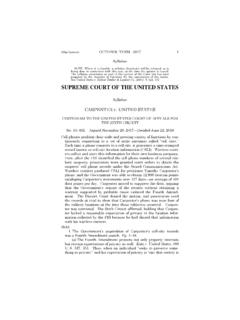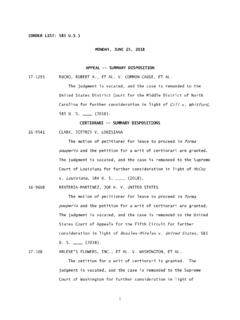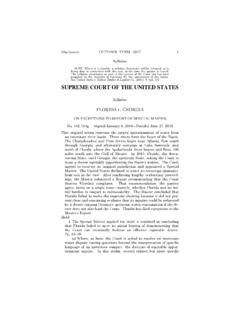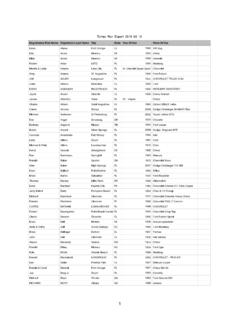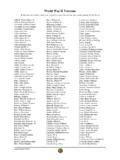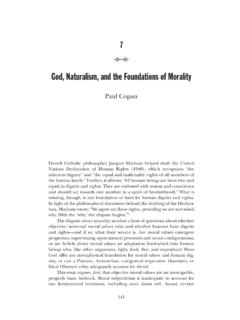Transcription of SUPREME COURT OF THE UNITED STATES
1 1 (Slip Opinion) OCTOBER TERM, 2016 Syllabus NOTE: Where it is feasible, a syllabus (headnote) will be released, as isbeing done in connection with this case, at the time the opinion is syllabus constitutes no part of the opinion of the COURT but has beenprepared by the Reporter of Decisions for the convenience of the reader. See UNITED STATES v. Detroit Timber & Lumber Co., 200 U. S. 321, 337. SUPREME COURT OF THE UNITED STATES Syllabus COOPER, GOVERNOR OF NORTH CAROLINA, ET AL.
2 V. harris ET AL. ON APPEAL FROM THE UNITED STATES DISTRICT COURT FOR THE MIDDLE DISTRICT OF NORTH CAROLINA No. 15 1262. Argued December 5, 2016 Decided May 22, 2017 The Equal Protection Clause of the Fourteenth Amendment prevents a State, in the absence of sufficient justification, from separating itscitizens into different voting districts on the basis of race. Bethune-Hill v. Virginia State Bd. of Elections, 580 U. S. ___, ___. When a voter sues state officials for drawing such race-based lines, this COURT s decisions call for a two-step analysis.
3 First, the plaintiff mustprove that race was the predominant factor motivating the legisla-ture s decision to place a significant number of voters within or with-out a particular district. Miller v. Johnson, 515 U. S. 900, 916. Sec-ond, if racial considerations did predominate, the State must prove that its race-based sorting of voters serves a compelling interest and is narrowly tailored to that end, Bethune-Hill, 580 U. S., at ___. This COURT has long assumed that one compelling interest is compli-ance with the Voting Rights Act of 1965 (VRA or Act).
4 When a Stateinvokes the VRA to justify race-based districting, it must show (to meet the narrow tailoring requirement) that it had good reasons for concluding that the statute required its action. Alabama Legisla-tive Black Caucus v. Alabama, 575 U. S. ___, ___. A district COURT s factual findings made in the course of this two-step inquiry are re-viewed only for clear error. See Fed. Rule Civ. Proc. 52(a)(6); Easley v. Cromartie, 532 U. S. 234, 242 (Cromartie II).This case concerns North Carolina s redrawing of two congressionaldistricts, District 1 and District 12, after the 2010 census.
5 Prior to that redistricting, neither district had a majority black voting-agepopulation (BVAP), but both consistently elected the candidates pre-ferred by most African-American voters. The new map significantly altered both District 1 and District 12. The State needed to add al- 2 COOPER v. harris Syllabus most 100,000 people to District 1 to comply with the one-person-one-vote principle, and it chose to take most of those people from heavily black areas of Durham increasing the district s BVAP from The State also reconfigured District 12, increasing its BVAP from to Registered voters in those districts (here called the plaintiffs ) filed suit against North Carolina officials (collective-ly, the State or North Carolina ), complaining of impermissible ra-cial gerrymanders.
6 A three-judge District COURT held both districts unconstitutional. It found that racial considerations predominated inthe drawing of District 1 s lines and rejected the State s claim that this action was justified by the VRA. As for District 12, the COURT again found that race predominated, and it explained that the Statemade no attempt to justify its attention to race in designing that dis-trict. Held: 1. North Carolina s victory in a similar state- COURT lawsuit does notdictate the disposition of this case or alter the applicable standard ofreview.
7 Before this case was filed, a state trial COURT rejected a claim by several civil rights groups that Districts 1 and 12 were unlawful racial gerrymanders. The North Carolina SUPREME COURT affirmed that decision under the state- COURT equivalent of clear error State claims that the plaintiffs are members of the same organi-zations that brought the earlier case, and thus precluded from raisingthe same questions anew. But the State never satisfied the District COURT that the alleged affiliation really existed. And because the Dis-trict COURT s factual finding was reasonable, it defeats North Caroli-na s attempt to argue for claim or issue preclusion here.
8 The State s backup argument about the proper standard of review also falls short. The rule that a trial COURT s factual findings are re-viewed only for clear error contains no exception for findings that di-verge from those made in another COURT . See Fed. Rule Civ. Proc. 52(a)(6). Although the state COURT s decision is certainly relevant, the premise of clear error review is that there are often two permissibleviews of the evidence. Anderson v. Bessemer City, 470 U. S. 564, 574. Even assuming that the state COURT s findings capture one suchview, the only question here is whether the District COURT s assess-ment represents another.
9 Pp. 7 The District COURT did not err in concluding that race furnished the predominant rationale for District 1 s redesign and that the State s interest in complying with the VRA could not justify that con-sideration of race. Pp. 10 18.(a) The record shows that the State purposefully established a racial target for the district and that the target had a direct and sig-nificant impact on the district s configuration, Alabama, 575 U. S., 3 Cite as: 581 U. S. ____ (2017) Syllabus at ___, subordinating other districting criteria.
10 Faced with this body of evidence, the District COURT did not clearly err in finding that race predominated in drawing District 1; indeed, it could hardly have con-cluded anything but. Pp. 10 12.(b) North Carolina s use of race as the predominant factor in de-signing District 1 does not withstand strict scrutiny. The State ar-gues that it had good reasons to believe that it had to draw a majori-ty-minority district to avoid liability for vote dilution under 2 of theVRA. Thornburg v. Gingles, 478 U. S. 30, identifies three threshold conditions for proving such a vote-dilution claim: (1) A minority group must be sufficiently large and geographically compact to con-stitute a majority in some reasonably configured legislative district, id.
